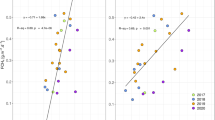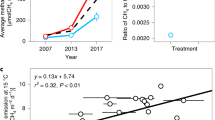Abstract
WETLANDS provide up to 25% of the annual global flux of methane—an important greenhouse gas—to the atmosphere1–3. Despite many studies4–9, however, the factors that control emission from wetlands are uncertain. Methane production and transport by rooted vegetation10–15 have been emphasized, but methane oxidation has received little attention. Methane oxidation has been observed in a hardwood swamp7 and may consume >90% of the potential flux from rice paddies16–19. Here I report results from a Danish wetland which suggest that methane oxidation is highly variable, consuming <10% to >90% of the potential methane flux. Laboratory experiments suggest that this variability may be due in part to light-mediated changes in oxygen distribution within illuminated sediments. These results indicate that diffusive fluxes of methane from wetlands may be controlled by rates of oxidation, in addition to rates of methane production. Failure to consider the dynamics and controls of methane oxidation in methane-flux studies could result in incorrect estimates of wetland emission rates.
This is a preview of subscription content, access via your institution
Access options
Subscribe to this journal
Receive 51 print issues and online access
$199.00 per year
only $3.90 per issue
Buy this article
- Purchase on Springer Link
- Instant access to full article PDF
Prices may be subject to local taxes which are calculated during checkout
Similar content being viewed by others
References
Wahlen, M. et al. Science 245, 286–290 (1989).
Matthews, E. & Fung, I. Global biogeochem. Cycles 1, 61–86 (1987).
Ehhalt, D. H. & Schmidt, U. Pure appl. Geophys. 116, 452–464 (1978).
Baker-Blocker, A., Donahue, T. M. & Mancy, K. H. Tellus 29, 245–250 (1977).
Cicerone, R. J. & Shetter, J. D. J. geophys. Res. 88, 7203–7209 (1981).
Harriss, R. C. & Sebacher, D. I. Geophys. Res. Lett. 8, 1002–1004 (1981).
Harriss, R. C., Gorham, E., Sebacher, D. I., Bartlett, K. B. & Flebbe, P. A. Nature 315, 652–654 (1982).
Bartlett, K. B. et al. J. geophys. Res. 93, 1571–1582 (1988).
Wilson, J. O. et al. Biogeochemistry 8, 55–71 (1989).
King, G. M. & Wiebe, W. J. Estuar. Coast. mar. Sci. 10, 215–223 (1980).
Zeikus, J. G. & Winfrey, M. J. Appl. envir. Microbiol. 31, 99–107 (1976).
Dacey, J. W. H. & Klug, M. J. Science 203, 1253–1254 (1979).
Dacey, J. W. H. Ecology 62, 1137–1147 (1981).
Holzapfel-pschorn, A., Conrad, R. & Seiler, W. Pl. Soil 92, 223–233 (1985).
Sebacher, D. I., Harriss, R. C. & Bartlett, K. B. J. envir. Qual. 14, 40–46 (1985).
Harriss, R. C., Sebacher, D. I. & Day, F. P. Jr Nature 297, 673–674 (1982).
DeBont, J. A. M., Lee, K. K. & Bouldin, D. F. Ecol. Bull., Stockholm 26, 91–96 (1976).
Holzapfel-pschorn, A., Conrad, R. & Seiler, W. FEMS Microbiol. Ecol. 31, 343–351 (1985).
Schutz, H., Conrad, R. & Seiler, W. Biogeochemistry 7, 33–53 (1989).
Bedard, C. & Knowles, R. Microbiol. Rev. 53, 68–84 (1989).
Salvas, P. L. & Taylor, B. F. Curr. Microbiol. 4, 305–308 (1980).
Frenzel, P., Thebrath, B. & Conrad, R. FEMS Microbiol. Ecol. 73, 149–158 (1990).
Revsbech, N. P., Jørgensen, B. B. & Blackburn, T. H. Limnol. Oceanogr. 28, 1062–1074 (1983).
Revsbech, N. P., Nielsen, J. & Hansen, P. K. in Nitrogen Cycling in Coastal Marine Ecosystems (eds Blackburn, T. H. & Sørensen, J.) 69–83 (Wiley, New York, 1988).
Jensen, J. & Revsbech, N. P. FEMS Microbiol. Ecol. 62, 29–38 (1989).
Wertlieb, D. & Vishniac, W. J. Bacteriol. 93, 1722–1724 (1967).
Blackburn, T. H., Kleiber, P. & Fenchel, T. Oikus 26, 103–108 (1975).
Revsbech, N. P., Jørgensen, B. B. & Brix, O. Limnol. Oceanogr. 26, 717–730 (1981).
Revsbech, N. P., Madsen, B. & Jørgensen, B. B. Limnol. Oceanogr. 31, 293–304 (1986).
Carlton, R. G. & Wetzel, R. G. Limnol. Oceanogr. 33, 562–570 (1988).
Reeburgh, W. S. & Heggie, D. T. Limnol. Oceanogr. 22, 1–9 (1977).
Kuivila, K. M., Murray, J. W., Devol, A. H., Lidstrom, M. E. & Reimers, C. E. Limnol. Oceanogr. 33, 571–581 (1988).
Author information
Authors and Affiliations
Rights and permissions
About this article
Cite this article
King, G. Regulation by light of methane emissions from a wetland. Nature 345, 513–515 (1990). https://doi.org/10.1038/345513a0
Received:
Accepted:
Issue Date:
DOI: https://doi.org/10.1038/345513a0
This article is cited by
-
Biotic and Abiotic Control Over Diurnal CH4 Fluxes in a Temperate Transitional Poor Fen Ecosystem
Ecosystems (2023)
-
Bark-dwelling methanotrophic bacteria decrease methane emissions from trees
Nature Communications (2021)
-
Microbial nitrogen fixation and methane oxidation are strongly enhanced by light in Sphagnum mosses
AMB Express (2020)
-
Methane distribution and methane oxidation in the water column of the Elbe estuary, Germany
Aquatic Sciences (2017)
-
Methane oxidation coupled to oxygenic photosynthesis in anoxic waters
The ISME Journal (2015)
Comments
By submitting a comment you agree to abide by our Terms and Community Guidelines. If you find something abusive or that does not comply with our terms or guidelines please flag it as inappropriate.



